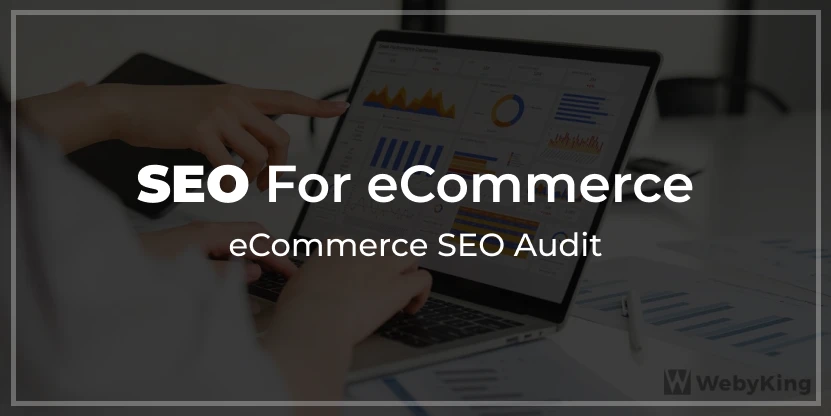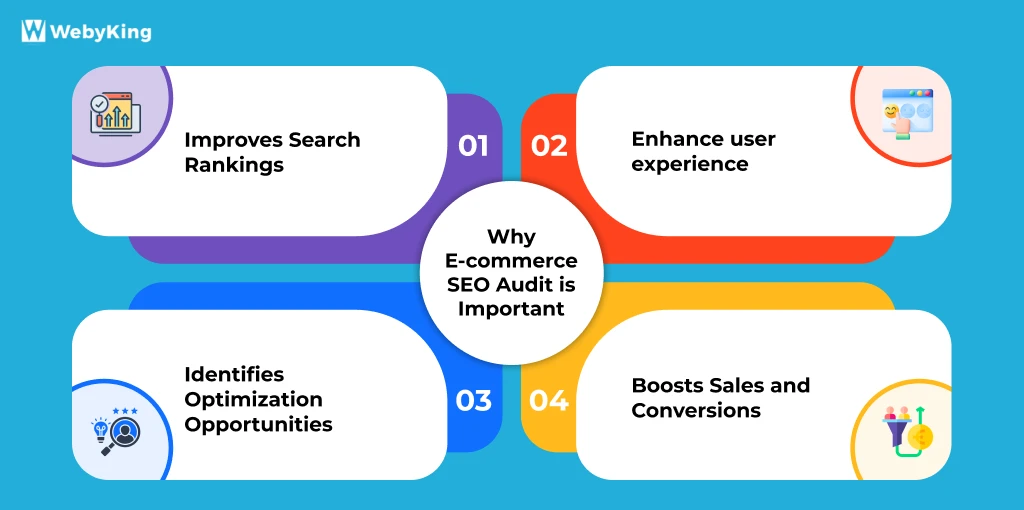How to Perform an eCommerce SEO Audit? A Simple Guide

- What is eCommerce SEO and Why It Is Important?
- 11 eCommerce SEO Best Practices in 2025
- How to Perform an eCommerce SEO Audit? A Simple Guide
- Top eCommerce SEO Trends to Watch in 2025
- How Much Does eCommerce SEO Cost in 2025? A Complete Breakdown
- The Importance of Technical SEO for Your eCommerce Store
- Should You Hire an eCommerce SEO Expert or Do It Yourself?
Get In Touch
Search Engine Optimization (SEO) is a crucial aspect of eCommerce shops. Organic traffic is (often) the lifeblood of consistent sales and long-term growth for many online stores. Even for multi-channel businesses, a well-optimized online store means that prospective customers will discover your products at the right time, with the least friction.
So, a comprehensive eCommerce Audit is not just handy but mandatory. Whether you plan to hire an eCommerce SEO expert or do it yourself, understanding your website’s strengths and weaknesses through an audit is the first step to improving performance.
A regular SEO audit can help you address technical issues, optimize your site structure, improve product page visibility, and help you align your content with what your target audience is searching for.
An eCommerce SEO audit digs into the fundamentals that influence how search engines crawl, read, and rank your site, from crawlability and indexation to site speed, mobile usability, and structured data implementation. In this guide, we will explain each stage of the audit process, optimize your store and show you where you can enhance your performance especially in plentiful results in search engines.
What is an eCommerce SEO Audit?
An eCommerce SEO audit is a thorough health check for the visibility of your online store in search engines. Simply put, it is the process of assessing your website to ensure it is optimized for search engines such as Google. This includes
- Technical elements (such as site speed and mobile-friendliness)
- On-page SEO (example product title & description) and
- On-page factors (such as keywords).Off-page factors (such as backlinks)
This means finding out what your store is doing wrong that’s stopping it from ranking on the first page of a search result—and then fixing it by applying proven eCommerce SEO best practices to attract more visitors, improve user experience, and increase sales.
Why It Matters:
- 70 % of marketers say SEO is more effective than PPC for driving sales in the long term.
- Amazon’s SEO strategy focuses heavily on keyword-rich product pages, fast load times, and structured data- key elements you’ll evaluate in an audit.
A well-done SEO audit can uncover:
- Broken links and crawl errors
- Duplicate content or missing metadata
- Slow-loading pages that affect bounce rates
- Opportunities to better target high-converting keywords
For instance, when Zappos overhauled its site structure and optimized product pages through an SEO audit, it saw a 15% increase in organic traffic within months.
By regularly auditing your eCommerce site, you’re not just ticking an SEO box- you’re actively boosting your store’s chances of being found by the right customers.

How to Conduct an eCommerce SEO Audit? Steps to Perform
SEO isn’t a one-time deal; it’s a continuous journey. Regular SEO audits are like health checkups for your website. They help you identify technical and content issues, grab opportunities, and ensure your eCommerce store is well-performed.
Here’s a breakdown of the eCommerce SEO audit process, grouped into Technical SEO, On-page SEO, and Off-page SEO, to improve the store’s weaknesses, letting it rank well on Search Engines.
Technical SEO
Technical eCommerce SEO audits lay the groundwork for your site’s visibility and are composed of the following parts:
- Crawl the Website: Start by using tools like Screaming Frog or Sitebulb to crawl your eCommerce store. This helps you discover broken links, missing metadata, or redirect chains.
- Check Indexing Status: See how many of your pages are indexed versus how many should be in Google Search Console. Such may result in lost traffic and missed sales. Submit sitemaps if needed.
- Fix Crawl Errors: Know which pages give a 404 or are blocked from crawling. The mentioned mistakes are harmful to user experience and waste crawl budget. Correcting them allows Google to crawl and index your pages.
- Identify Orphaned Pages: Orphaned pages are those pages not linked to anywhere on your site and thus invisible to the users as well as search engines. More common for large eCommerce stores that have a range of outdated products. Interlink them through relevant category pages or interlinks.
- Review Site Architecture: A well-defined, logical site structure allows users and search engines to discover your content effortlessly. When planning the structure of your website, you should strive to create a shallow hierarchy — it would be best if you can reach any product page in 3 clicks from the homepage.
- Inspect URL Structure: Do not use long strings having a session ids or unrequired parameters. This type of URL is easier for crawlers, which ultimately creates better SEO and a better user experience, such as ‘/means/shoes/running’ is better than ‘/prd? id=12345”.
- Audit Redirects: Fix redirect chains, loops and use 301s to guide users and bots to updated product pages.
- Test Mobile Usability: Run Google’s mobile test to catch layout or tap issues that hurt user experience on small screens.
- Analyze Page Speed: Use PageSpeed insights to fix slow-loading-pages -optimize images, scripts and enable caching.
- Ensure HTTPS Security: Your site must use HTTPS to protect transactions and build trust with both users and Google.
- Check XML Sitemap: Make sure all important pages are listed, updated, and error-free in your submitted sitemap.
- Validate Robot.txt: Ensure your Robot.txt isn’t blocking essential pages and includes your sitemap link.
- Use Structured Data (Schema): Add product Schema to show ratings, price, and stock in searches, boosting visibility and clicks.
On-page SEO
From product titles to category content, learn how to fine-tune every element for better visibility.
- Optimize Title Tag: Ensure that each page has a unique, keyword-rich title that represents the product or category of the website.
- Meta Description Tip: Tell them about your products clearly and relevantly in the descriptions, and make sure not to duplicate it across product pages.
- Header Tags Structure (H1 -H6): Only one H1 per page (usually the name of the product or the category) and logically structure the other headings.
- Features of Product Page SEO: SEO Keywords in Titles/Descriptions/Images- Optimize each product for Search and UX.
- Category Page SEO Optimization: Add SEO optimized content and intro text on category pages (broad, high volume keywords).
- Linking Structure: Related products, categories, and blog content links to each other, improving both crawlability as well as reducing time on site.
- Video Optimization (Thumbnails, Titles, Descriptions): Similar to the previous step, images require the use of descriptive video alt text, file/thumbnail names to be indexed by search engines.
- Image Optimization (Alt Text, File Names): Use descriptive titles, names, and alt text for all your images.
- Optimize URL Slugs: All URLs should be as brief, clean, and closely related to keywords as possible; avoid extraneous words, random number strings, etc.
- Breadcrumb Navigation: Use breadcrumbs to improve navigation and help search engines understand page hierarchy.
- User Experience (UX) Signals: Ensure fast load times, easy navigation, and clear CTAs to keep users engaged and reduce bounce rates.
- Mobile On-page Elements: Check mobile readability, button spacing, and layout-ensure everything works well on small screens.
- Faceted Navigation SEO: Use no index or canonical tags to avoid duplicate content caused by filtered category pages.
Content Audit
Content strategy plays a big role in eCommerce SEO. Evaluate the quality and uniqueness of product descriptions, blog posts, and other content on the website.
- Content Quality & Uniqueness: Ensure all content is original, helpful, and tailored to your products and audience. Copied or low-quality content can hurt rankings and user trust.
- Product Description Review: Audit descriptions to avoid duplicates and enrich them with features, benefits, and keywords. Unique, persuasive copy can improve both SEO and conversions.
- Category Page Optimization: Add short, keyword-optimized content to category pages for better context and rankings. Avoid leaving them as plain product grids without supporting text.
- Blog Content Strategy: Focus on topics that support your products, answer customer questions, and attract organic traffic.
- Duplicate Content Issues: Identify repeated content across product, variant, or filtered pages. Use canonical tags or rewrite copy to avoid SEO penalties.
- E-A-T Signals (Expertise, Authoritativeness, Trustworthiness): Showcase your brand’s credibility with author info, reviews, and trust signals. EAT is key for building confidence, especially in YMYL niches.
Off-page SEO
Next on the eCommerce SEO audit is off-page SEO. Off-page SEO includes factors that affect your store’s rankings but aren’t on your page, so you can’t update them directly. There are certain components you need to include:
- Analyze Backlink Profile: Use tools like Ahrefs or Semrush to review who’s linking to your store. Strong, relevant backlinks help boost your domain authority and rankings.
- Disavow Toxic Links: Identify spammy or irrelevant backlinks that could harm your site. Use Google’s disavow tool to avoid potential penalties.
- Check Brand Mentions: Monitor online mentions of your brand, even without a link. Turn unlinked mentions into backlinks by reaching out to site owners.
- Audit Competitor Links: Research where your competitors are getting backlinks from. This reveals potential outreach targets and link-building opportunities.
- Track Referral Traffic: Use Google Analytics to see which sites send traffic to yours. High-referral sources often indicate valuable link partnerships.
Use Google’s Mobile-Friendly Test to see how your site performs on mobile. Simply navigate, make buttons bigger, and reduce any pop-ups that might annoy mobile users. A smooth mobile shopping experience can boost your rankings and sales.
Many businesses are now opting for mobile-first optimization, which prioritizes mobile usability in the design and development process.
Smart SEO Tools for eCommerce Success
An eCommerce SEO audit is an in-depth analysis where you will also want to use tools that help you identify hidden technical issues, track performance, and highlight opportunities. And from technical SEO, to backlinks, to content analysis, these tools help make your workflow more efficient and drive data-informed decisions to increase visibility and sales for your store.
SEMrush
SEMrush — is a robust all-in-one SEO tools that helps you audit your website, monitor keywords, audit backlines, and spy on competitors. Awesome for finding out what keywords your competitors are ranking for and where your site stands.
In eCommerce, it’s particularly valuable for pinpointing product page SEO gaps and missed long-tail keyword opportunities.
Ahrefs
Ahrefs is popular for backlink analysis and keyword research. You can use it to examine your site’s backlink profile, identify toxic or broken links, and compare yourself to your competitors.
If your competitors’ product pages are being linked to by niche blogs or roundups, pitch your products to those same sources.
Screaming Frog
Similar to a search engine, Screaming Frog crawls your website and reports technical SEO malfunctions. It flags items such as missing meta tags, duplicate content, broken links, and redirect chains.
As far as large eCommerce stores go, it’s of extreme use for identifying orphaned product pages or title tags missing on mass product pages in a category.
Google Analytics
Google Analytics records how visitors are behaving on your on your site, where are they coming from, to what they are purchasing. You can see what products yield the highest conversion, which pages have the highest bounce rates, and what referral source is driving sales.
This data is used to optimize high-traffic, low-converting pages as well as to improve your overall SEO strategy.
Google Search Console
Search Console gives direct insight into how Google sees your site. It shows indexed pages, search queries, click-through rates, and any crawling or coverage issues.
For eCommerce, it’s essential for catching issues like non-indexed product pages or drops in impressions after launching a new collection.
Google PageSpeed Insights
PageSpeed Insights analyzes your site speed and user experience, especially on mobile. It gives specific suggestions for improving loading time, like image compression and script minimization.
For instance, if your product pages load slowly due to uncompressed images, PageSpeed will flag it and guide you on what to fix.
Get Started with Your eCommerce SEO Audit Today
We’ve covered all the essential steps to help you understand your store’s health, from technical fixes to content optimization. By following this audit, you’ll quickly identify areas that need improvement to boost rankings, traffic, and conversions.
Feeling overwhelmed? No worries! At WebyKing, our skilled SEO team is here to help you with reliable eCommerce SEO services tailored to your goals. We can audit your store, recommend strategies, and help you understand your eCommerce SEO cost before starting — ensuring full transparency and measurable results. Contact us to optimize your store and elevate your store’s online presence.
FAQs on eCommerce SEO Audit
What is an eCommerce SEO audit?
An eCommerce SEO audit evaluates your online store’s technical, on-page, and off-page SEO performance. It identifies issues that impact rankings, traffic, and conversions.
How often should I conduct an eCommerce SEO audit?
It’s recommended to perform an SEO audit at least once every 6 months. However, more frequent audits may be needed if you are regularly adding new products or updating content.
Why is site speed important in an eCommerce SEO audit?
Site speed directly affects user experience and conversion rates. Slow pages can lead to higher bounce rates and negatively impact your rankings in Google.
How does an SEO audit improve my eCommerce site’s sales?
An SEO audit identifies performance issues, keyword opportunities, and user experience improvements, all of which can lead to better rankings, more traffic, and higher sales.
Can an eCommerce SEO audit help with mobile optimization?
Yes! An SEO audit includes mobile usability checks, ensuring your site is fully responsive, easy to navigate, and optimized for mobile shoppers.










